Analysis Of Earthquake Wave Propagation In Buildings
Price
Free (open access)
Transaction
Volume
81
Pages
10
Published
2005
Size
474 kb
Paper DOI
10.2495/ERES050301
Copyright
WIT Press
Author(s)
H. Kawakami, M. Oyunchimeg & E. A. J. Tingatinga
Abstract
This paper presents a wave propagation modelling analysis of strong motion records for actual buildings in comparison with an analysis of simple building models. In previous studies on earthquake response of buildings, vibration approaches were used more often than wave propagation approaches; thus, wave propagation through a building has not been investigated enough. We use the normalized input output minimization (NIOM) method, which can model wave propagation in multiple linear systems by considering the statistical correlation among the strong motions at different observation locations. Output wave models simplified by this method show two clear peaks that correspond to incident and reflected waves propagating through the building in the vertical direction. The obtained wave propagation properties, such as wave travel time and wave amplitude ratio, at each story of the building are found to reflect the structural properties like rigidity and damping ratio at that story. Further, a new method for wave-propagation analysis—called evolutionary normalized input-output minimization—is developed. It models time-variant wave propagation by considering the time-variant statistical correlation between strong motions recorded at different levels in the building. In the case of damaged buildings, the travel time increased during the earthquake; however, in the cases of undamaged buildings and the elastic model, it remained almost constant during the earthquake. Keywords: strong motion records, buildings, wave propagation, wave travel time, wave amplitude, fundamental period, damping, damage.
Keywords
strong motion records, buildings, wave propagation, wave travel time, wave amplitude, fundamental period, damping, damage.





